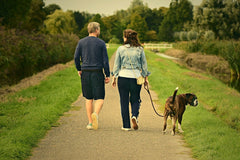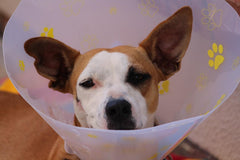
It's a matter of courtesy...
The muzzle is the utensil that dogs hate right away. A dog that has never worn a collar or harness that has never been leashed expresses disagreement when forced to do so, but not permanently. He quickly understands that the collar and leash are associated with walking and the discomfort of the first time is quickly forgotten.
With the muzzle, it's something else. Dogs don't want it and let it be known, each in his own way, but in any case by struggling and doing everything in their power to get rid of it... They'll have to get used to it, though. Why?
Because it's an event in the program for Ring and Obedience practitioners. They can't escape it. At the moment, muzzling is not on the program for the Certificate of Sociability and Fitness, but it will come.
Because categorized dogs are only allowed in public places if they are muzzled. Look at them: they don't have it so bad...
Last but not least, because it's a courtesy. Explanations.
You don't make a career as a dog user and judge without getting bitten sometime. Every time, it happens with a dog whose owner assures you that he is "not mean"... Thus it happened that a dog bites when the judge takes his license plate with the transponder or when he examines his teeth. The judge does not know the dog and does not know the owner either. When an exhibitor or competitor tries to reassure me by saying: "Don't be afraid, he is not bad", I always get the same answer: "I am not afraid of your dog. But I'm a little afraid of you... " It's a courtesy to know how to hold your dog. It is a courtesy to teach him to wear a soft muzzle because in some places it is mandatory. It's also more reassuring to the people you meet when you see a dog muzzled than to be told, "Aah, he's not a bad dog." Ask the vets. Also ask the groomers where the muzzle is worn by all clients...
Groomers invented a small dog muzzle 25-30 years ago, which is ultra-light and can be slipped over a dog's nose in seconds. This is what you have to use. Forget the big leather muzzles unless you're preparing the dog for muzzle attacks.
So get a plastic muzzle, too big for the dog. Familiarize the dog with this muzzle by letting it hang from his collar while walking or eating.
Place a piece of meat at the bottom of the muzzle and present it as a bowl.
Do not trap the dog this first time. He has eaten something good at the bottom of the muzzle and that's it. The next time, keep the muzzle on his snout for a few seconds. And so on and so on and so on. Then go back and let the dog help himself and take off his muzzle. You have to get him not to refuse to stick his nose in the muzzle and say, "Last time you got me, but I won't let you get me again. "
Continue, putting the muzzle down and rewarding him only after he has agreed to remain muzzled for a few seconds. You encourage and pet him, of course. Then when all this foreplay is over, muzzle him and go for a walk. The allure of the distraction will or should compensate for the inconvenience of the muzzle.
The hard way should be avoided, of course. First of all because it is painful for you as well as for the dog and also because the result would be random. You have to see how much energy a dog can use to get rid of the utensil... You also have to avoid that the dog makes the link between the muzzle and an unpleasant experience.
If you have succeeded in getting your dog to accept the muzzle, don't just put it on just before you get on the vet's table, which is probably not a place he likes. Because he would soon make the link between the two experiences and would be all the more afraid of both: the muzzle and the veterinarian...
The goal is for the dog to reach the muzzle by itself. Because he will find it if not comfortable, at least not embarrassing and he will associate it with a pleasure: the reward or the walk. And of course the caresses that you do not fail to lavish on him...
Law enforcement dogs
The muzzle, an instrument of courtesy, so to speak, is also an accessory of the police dog. A muzzled dog handler's defence is on the programme of the practical field work competition. For these exercises, the dogs are equipped with strong leather muzzles. The bottom of the muzzle is equipped with a metal frame so that the dog cannot cut it with a bite. Muzzled dogs, even when trained to bite, have a natural tendency to try to get rid of their muzzle before intervening against their master's aggressor. They must therefore be taught to defend, with the muzzle.
To do this, the dog is equipped with a muzzle that is wide enough and open at the bottom so that the dog can at least pinch or grasp the attacking man's suit with the tips of its teeth. The dog will be able to bite, not as deeply as he would like to, but he will not get frustrated and will not think about getting rid of this muzzle so constraining.
In use, in the hands of security guards or law enforcement, muzzled dogs intervene against aggressors, fugitives or assailants to make them fall or even to injure them, but the injury from the shock is still less than that which would be inflicted by a dog that bites with full teeth.
Sometimes police dogs are unmasked, but that's another matter...
Jean-Yves Reguer
How to put a muzzle on a dog?
Do muzzles stop dogs from barking?




